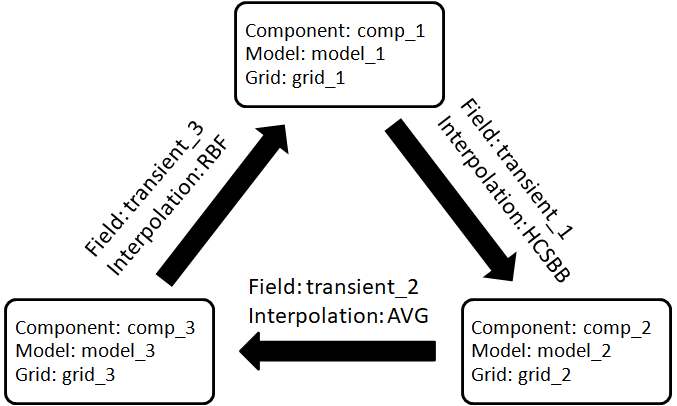Table of Contents
Introduction
YAC supports the use of a YAML file to configure the coupling between model components. This configuration file contains information such as:
- (optional) start- and end date of the run
- (optional) calendar to be used
- which fields are supposed to be coupled
- what interpolation is supposed to be used
- at which frequency the coupling is supposed to be executed
This configuration file can be read in at any time before the end of the definition phase. Couples defined in the configuration file whose source and/or target fields are not defined through the interface by the respective components are being ignored.
Description
start_date
Start date of coupling time range (e.g. 2008-03-09T16:05:07)
end_date
End date of coupling time range (e.g. 2008-03-10T16:05:07)
calendar
Calendar being used in the coupled run
(available options: proleptic-gregorian, 360d, and 365d)timestep_unit
The time period between couplings is defined by multiples of this time step unit
(available options: millisecond, second, minute, hour, day, month, year, and ISO_format)coupling
List of fields to be coupled and their configuration.
Each coupling is defined by the following parameters, which can be given in any order.src_component
Name of the source component
tgt_component
Name of the target component
src_grid
Name of the source grid
tgt_grid
Name of the target grid
src_lag (optional; default value: 0)
Used to adjust the internal event trigger clock for the source
Timelag of 2 will put forward the internal clock for the put event by 2 times the sourcetime step.
tgt_lag (optional; default value: 0)
Used to adjust the internal event trigger clock for the target
coupling_period
Defines at which interval the target processes should receive data through its get call.
It is given in multiples of the time step unit.Coupling period must be an integer multiple of the source/target time step.
time_reduction (optional; default value: none)
Gives the user the option to define how YAC is supposed to handle the source data provided by put that do not match the coupling_period due to a higher frequency.
(available options: accumulate, average, minimum, maximum, and none)weight_file_name (optional)
Specifies the name of a weight file that will be written by YAC, if the field is coupled. It contains the result of the whole interpolation stack.
If no weight file name is given, no weight file will be generated.The weight file can be read in by the user-file interpolation method
YAC will do the reading and writing of wight files in parallel. This parallel IO can be configured as described here: Configuration of parallel IO in YAC
mapping_side (optional; default value source)
Specifies at which component the weights will be stored and applied to the data in order to interpolate the respective field.
(available options: source and target)scale_factor (optional; default value 1.0)
All interpolated target points that do not receive the value of the fixed interpolation or the fallback value of the dynamic fractional masking will be multiplied by this value.
scale_summand (optional; default value 0.0)
This value will be added to all interpolated target points that do not receive the value of the fixed interpolation or the fallback value of the dynamic fractional masking.
field
Name of the field to be coupled.
field: TAUX
If multiple fields have the same coupling configuration, a
list of field names can be provided.field: [TAUX, TAUY]
If the source and target component use a different field name, the names are specified as follows:
field: src: TAUX_out tgt: TAUX_in
interpolation
Contains a list of Interpolation methods, which yield the Interpolation stack
src_mask_name
Name of source mask (see Named masks)
If the source data consists of multiple source fields, use the key src_mask_names and provide an array of mask names.
tgt_mask_name
Name of target mask (see Named masks)
*
Any unknown root key will be ignored by YAC.
Example

YAML Features
YAC uses libfyaml to read its YAML configuration files. This library fully supports YAML Version 1.2.
Therefore, features like anchhors, aliases, and merge keys can be used in the configuration file.
Example
The following is a valid configuration file: